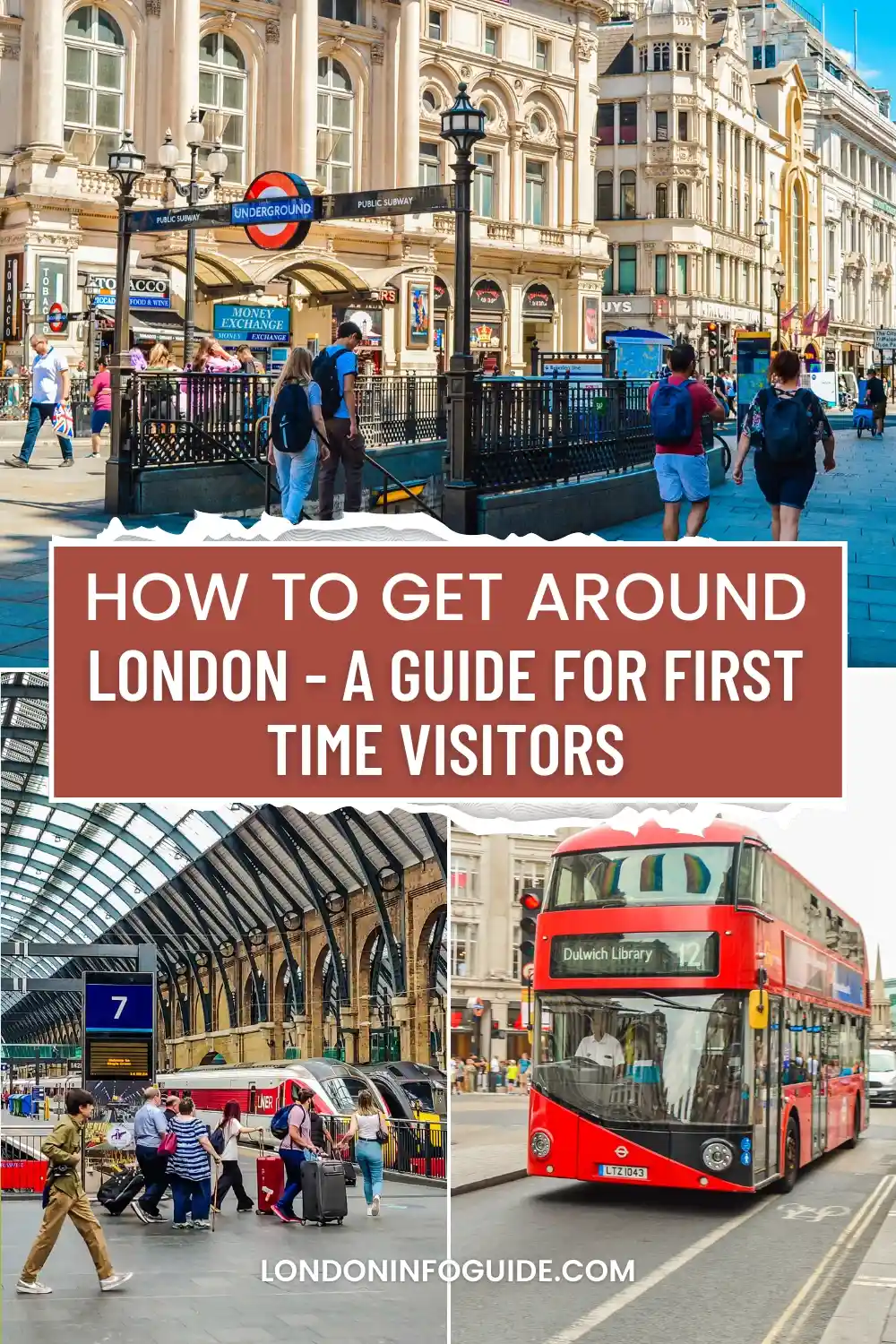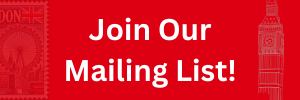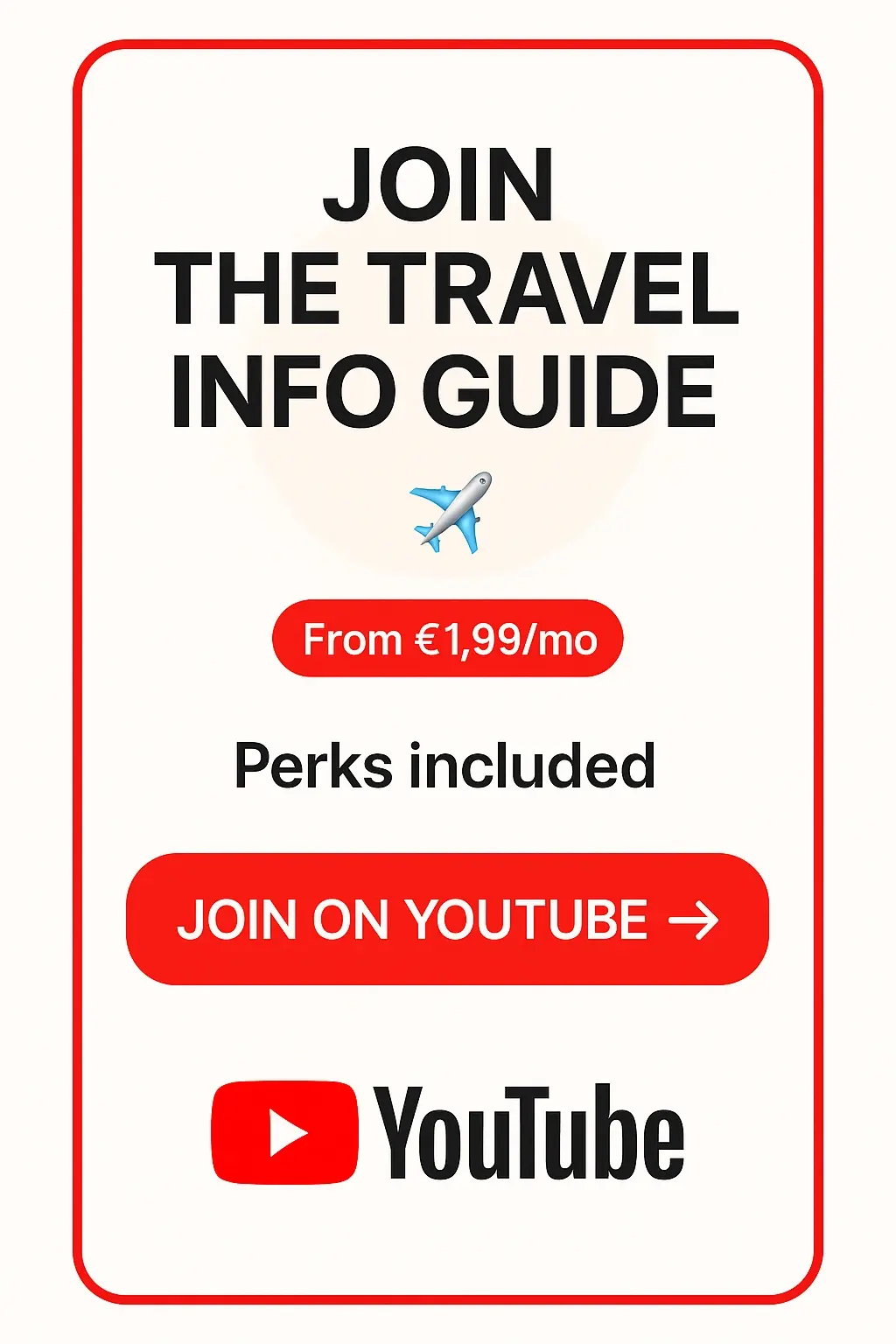- Home
- Where Is London In UK
- How to Get Around London
how to get around london
Your Personal Guide To Transport In London
Navigating London's extensive public transport can be overwhelming for first-time and returning visitors using new modes of transport. In our guide, we share the variety of transportation options on how to get around London.
London's transport system is one of the world's most extensive and diverse, including the renowned London Underground (Tube), the red double-decker bus, black cabs and increasingly popular bicycle routes. Each form of transportation has distinct advantages and may be selected depending on convenience, cost, personal taste and what you intend to do.
Drawing from our several visits to London and thorough online research we can share expert advice on getting around effortlessly.
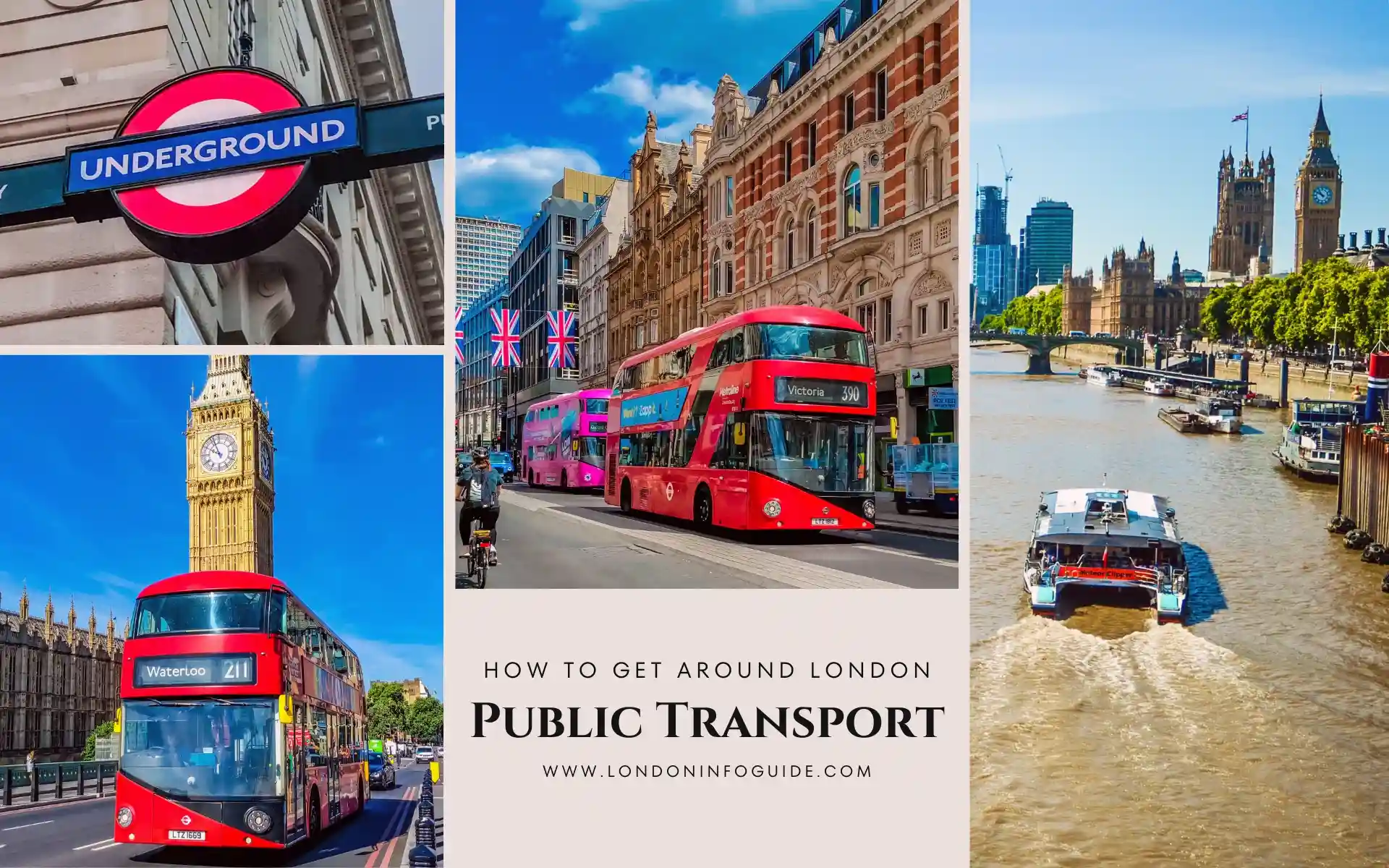 How to Get Around London By Public Transport
How to Get Around London By Public TransportVarious types of transport covering greater London
- London Underground (The Tube): Efficient, comprehensive network serving Greater London with regular services.
- London Overground: Complements the Tube network by effectively serving suburban and urban regions.
- Buses: Iconic red double-deckers, 24-hour service, and a large route network.
- Docklands Light Railway (DLR): Automated, driverless trains serve Docklands and link vital sites.
- London Trams: Reliable and efficient, primarily serving Croydon and the surrounding area.
- River Bus Services: A scenic way to travel the Thames that is more efficient than driving.
- Taxis and Ride-Sharing: Traditional black taxis as well as the commonly available Uber and Bolt services.
- Cycling & Walking: Extensive bike lanes and popular bike-sharing systems. Pedestrian-friendly, conveniently accessible landmarks, parks, and attractions.
- IFS Cloud Cable Car: A scenic Thames crossing that connects Greenwich Peninsula and Royal Docks.
How to get around the United Kingdom using the UK's Public Transport from London
- Airports and Transfers: Direct connections to London's major airports.
- The National Rail Network: Several stations spread across London which connect with nationwide destinations, offering extensive rail services across the UK.
- Eurostar: High-speed train linking London with major European cities.
- Coaches and Connections: Long-distance services from key stations, ideal for UK travel.
Navigating London: Essential Tips For First-Time Visitors
Frequently Asked Questions: Questions about how to get around London.
🎅 London Christmas Planning 2025 Starts Now!
- 🏨 Best Hotels in London for Christmas
- 🎄 Christmas in London Guide: Events | Lights | Markets | Tours
- ✨ Best Areas to Stay in London
- 🎁 Luxury Hotels in London
- ❄️ Weather In London For Christmas
- 🎟️ Things to Do in London in December
- 🛍️ Shopping in London at Christmas 2025
- 🎡 Visit Winter Wonderland at Hyde Park in London
- 🏨 Best Hotels Close to Winter Wonderland
underground in london - how to use the tube
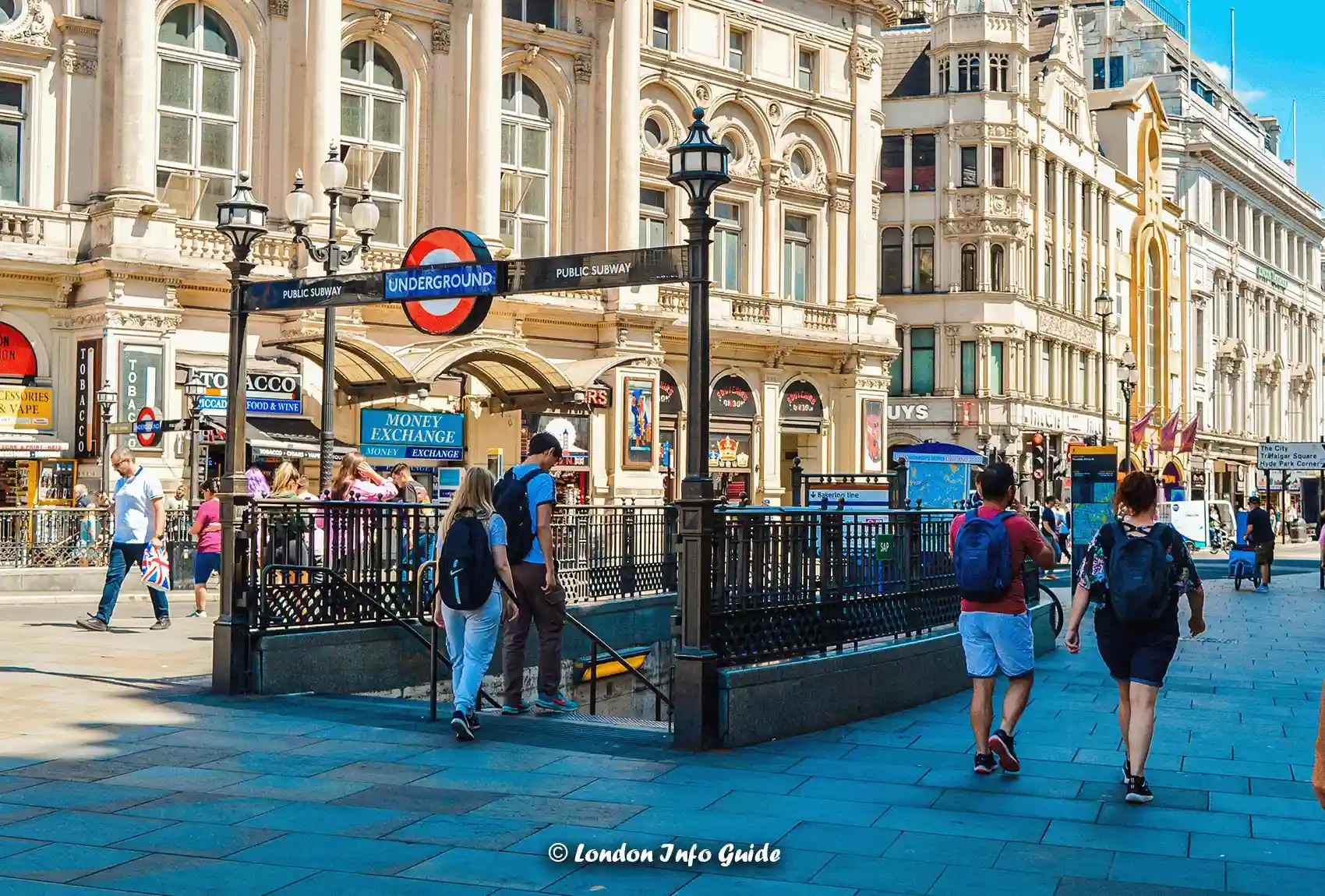 The London Underground Tube: Your guide to convenient and efficient city travel.
The London Underground Tube: Your guide to convenient and efficient city travel.The London Underground also known as 'metro' or 'the tube' was established in 1863. The London Underground consists of 402 km or 250 miles and 272 stations. This vast transport system transports between two and three million passengers daily from 5:00 AM to midnight and is the world's oldest underground metro (railway) network.
Initially, it was known as the Metropolitan Railway, and opened between Paddington and Farringdon, serving six intermediate stations. The Tube avoids street traffic, making it one of the most efficient ways to get around London. As of 2022, King's Cross Station is one of the busiest stations, with over 70 million passengers.
how to ride the london underground
Learn London's efficient Underground: rates, tickets, security, mobile connectivity, and travel suggestions for a smooth ride across the city.
- Ticket Prices: All passengers may easily access fare options and tariffs by purchasing tickets from machines or ticket offices at stations.
- How to pay London underground: Fares vary depending on travel zone, time of day, and payment mode, which includes Oyster card, contactless payment, and cash.
- How much is London Underground: The London Underground price structure is based on zones, peak/off-peak periods, and payment methods, with discounts and daily/weekly limitations for limitless travel.
- Underground Zones In London: It operates in fare zones 1–6, which span London in growing concentric circles, with zone 1 in the core and zone 6 on the outside. In general, the more zones you go through, the higher the cost.
- Efficiency: In most parts of London, there is an underground station within easy walking distance, with a train coming in 10 minutes or fewer. Because it is not constrained by traffic or streets, the underground is one of the most efficient modes of transport and is frequently the best option.
- Security: CCTV cameras are installed throughout the subterranean stations to provide a low-crime environment. Staff will remove any unattended objects for security concerns. Any odd behaviour should be reported to a staff member. Most stations feature access and exit barriers to ensure ticket validation and smooth passenger movement along the network.
- Mobile Phones: Uninterrupted 4G and 5G coverage is being spread across the London Underground, with 80% of stations linked by 2024. Phones connect instantly, allowing calls, messages, and internet access underneath.
- Best App for London Underground: Use the London app for the transport systems as it gives real-time updates, route planning, fare calculations, and service alerts, which improves convenience, efficiency, and ease of travel across the city.
- Frequency: Trains come every 10 minutes or less, providing regular and dependable service across the London Underground network.
- Operation: Services are available from 5 AM to midnight every day, ensuring comprehensive coverage for early and late-night travellers.
- Availability: Some lines provide 24-hour service on weekends to meet night-time travel requirements and ensure uninterrupted service.
- Logo: The characteristic London Underground emblem consists of a red circle with the phrase "Underground" in a blue box.
- Tips: Avoid using the Underground during weekday rush hours (7:30-8:30 AM and 4:30-7:00 PM) to avoid crowds.
- Convenience: Get further information from the official Transport for London (TfL) website.
- Map of London Underground Lines: Download the Tube map app to navigate routes easily or check the map of underground stations in London here.
the elizabeth line
The Elizabeth Line is a major new railway line that runs east-west through London and beyond, improving connectivity and cutting travel times.
It runs from Reading and Heathrow in the west to Shenfield and Abbey Wood in the east, passing through central London, with major stops including Paddington, Bond Street, Liverpool Street, and Canary Wharf.
Fares are integrated with the London fare zone system, and payment is accepted by Oyster cards, contactless payments, or Travelcards, as with other TfL services.
The Elizabeth Line operates from early morning to late at night and provides regular service, with trains operating every 5 minutes during peak periods in central London. All stations are completely accessible, with step-free access, elevators, and large doors.
The line connects smoothly with other TfL services, including the Underground, Overground, DLR, and National Rail.
The TfL website or app can provide extra information, and travel recommendations, and help you avoid peak periods. The amenities and services stated for the London Underground are equally applicable to the Elizabeth Line, creating a smooth travel experience.
- Check out both the stations and routes of the Elizabeth Line.
How we use the public transportation in london
Every time we head to London, our mode of transportation is mostly the underground, because it is the most efficient in our opinion. Apart from that, we usually take the red double-decker buses to travel short distances and also to take advantage of the scenery while on the move. We believe these modes of transportation offer a unique experience in exploring several London must-see and do destinations.
london Transport overground
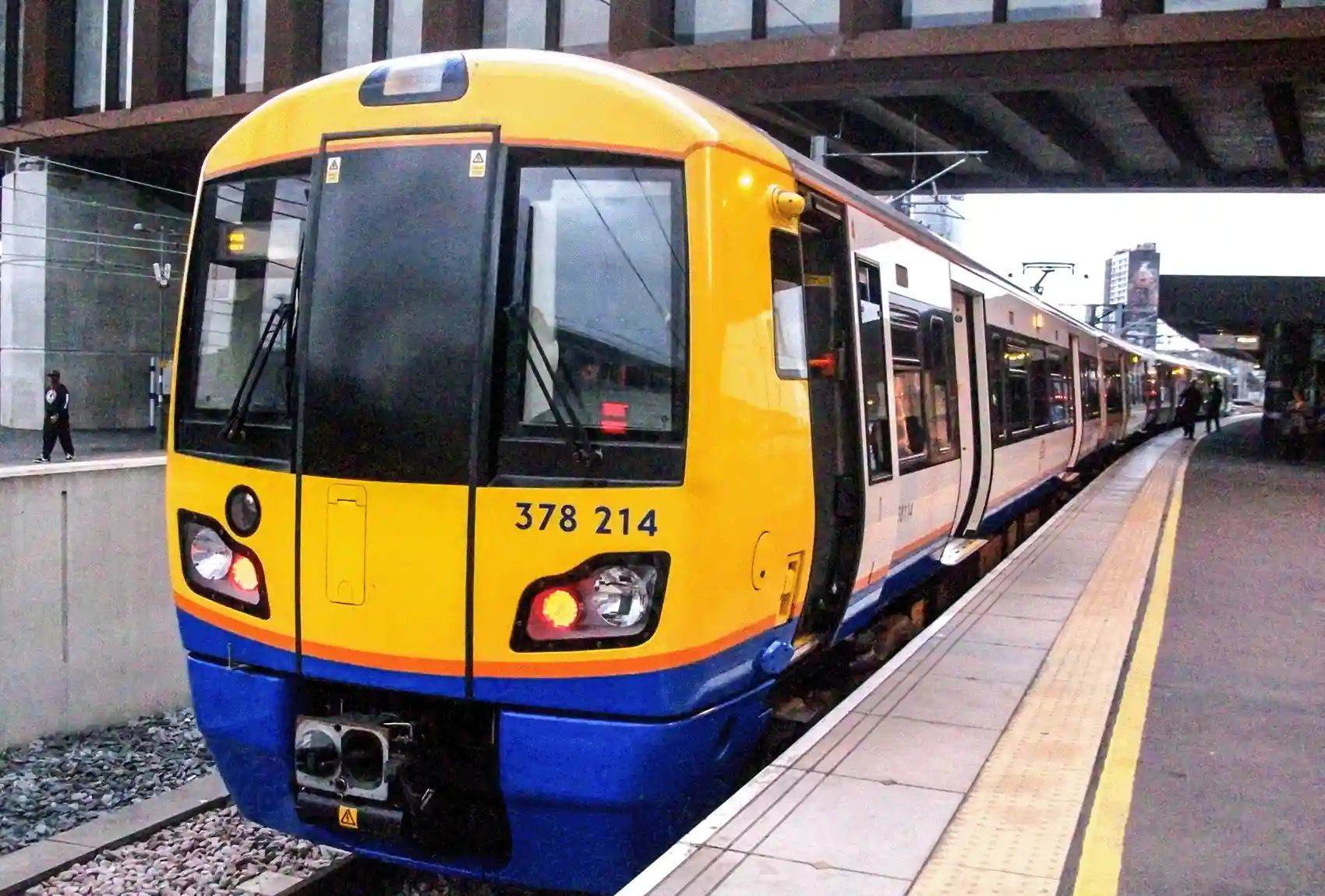 How to Get Around London | London's Overground Connecting You Across The City
How to Get Around London | London's Overground Connecting You Across The CityLondon Overground is the main suburban train network that connects Greater London with the city centre, with train terminals in Euston and Liverpool Street. The network runs several routes that can carry passengers throughout the capital, without going directly into the city.
The London Overground is another rail transport mode that serves both residents and visitors, spanning many of the London Boroughs. The network consists of around 113 stations across 167 kilometres (104 miles) of tracks, efficiently connecting outer areas with central London. Operated by Transport for London (TfL), the Overground is an integral part of the city's public transportation network, providing a suburban rail alternative to the Underground.
The London Overground is a suburban rail network serving Greater London, connecting outer areas with central London, and offering an efficient alternative to the Underground.
- Colours: The Overground Trains' distinctive orange and white hues make them easy to see.
- Zones: The network passes across many zones, from Zone 1 in Central London to Zone 9 in the suburbs of London.
- Contactless Payments: Oyster cards and contactless payments are accepted. The fares are based on transit zones, similar to the Underground.
- Operating Hours: Services operate from early morning around 5:30 AM to late night around midnight.
- Peak Hours: Avoid commuting during morning and evening rush hours (weekdays from 7 am to 8.45 am and 4.30 pm to 6.45 pm). Trains often operate, so there's no need to rush; simply wait for the next available service.
- Peak Times include trains travelling between 06:30 and 09:30 am and 4:00 pm and 7:00 pm.
- Interchange Stations: Many Overground stations have direct connections to the London Underground, DLR, and National Rail services.
- Frequency: Trains typically operate every 5-10 minutes during peak periods, with slightly longer intervals during off-peak hours.
- Line Identification: Overground lines are colour-coded on maps and designated by the terminal stations they serve.
- Airport Connection: It does not provide direct access to any airports. However, it allows convenient access to mainline stations serving the various London airports.
- Integration with Other Transport: Through seamless connections with the London Underground, buses, and other rail services, the Overground offers comprehensive and flexible travel options.
- Accessibility: Many Overground stations provide step-free access, elevators, and ramps.
- Routes and Destinations: The Overground serves various parts of London, including Stratford, Richmond, Clapham Junction, and Watford Junction, providing extensive coverage across the city and beyond.
- London Overground Map: See here a map displaying all lines and connections in the network.
- Real-Time Updates: Live service updates are provided on the TfL website, app, and station information boards. Plan your journey using TfL's Journey Planner service.
first-time visitor travel questions
Every visitor has questions about travelling to a new destination. We have put together the most popular questions and dedicated guides for each.
- What is the weather like and how does it fluctuate on a month-by-month basis?
- Which neighbourhoods are best to stay in London?
- What can I do in London on a rainy and stormy day?
- Which areas around London can I visit and have a good time?
- Are there any free attractions in London for a budget-friendly holiday?
- Will you be visiting London for the first time? Explore our essential tips!
- Are you wondering whether London is worth visiting? Check out our guide!
- Packing for London? Check out all the vital things you must pack!
- What currency does London use? A detailed guide into using the currency.
- What time zone does London England use?
- How many days should you spend in London? Find our best answer in this guide!
- Planning your first trip to London? Don’t miss our complete guide on the things to know before visiting London
The iconic red double decker bus in London
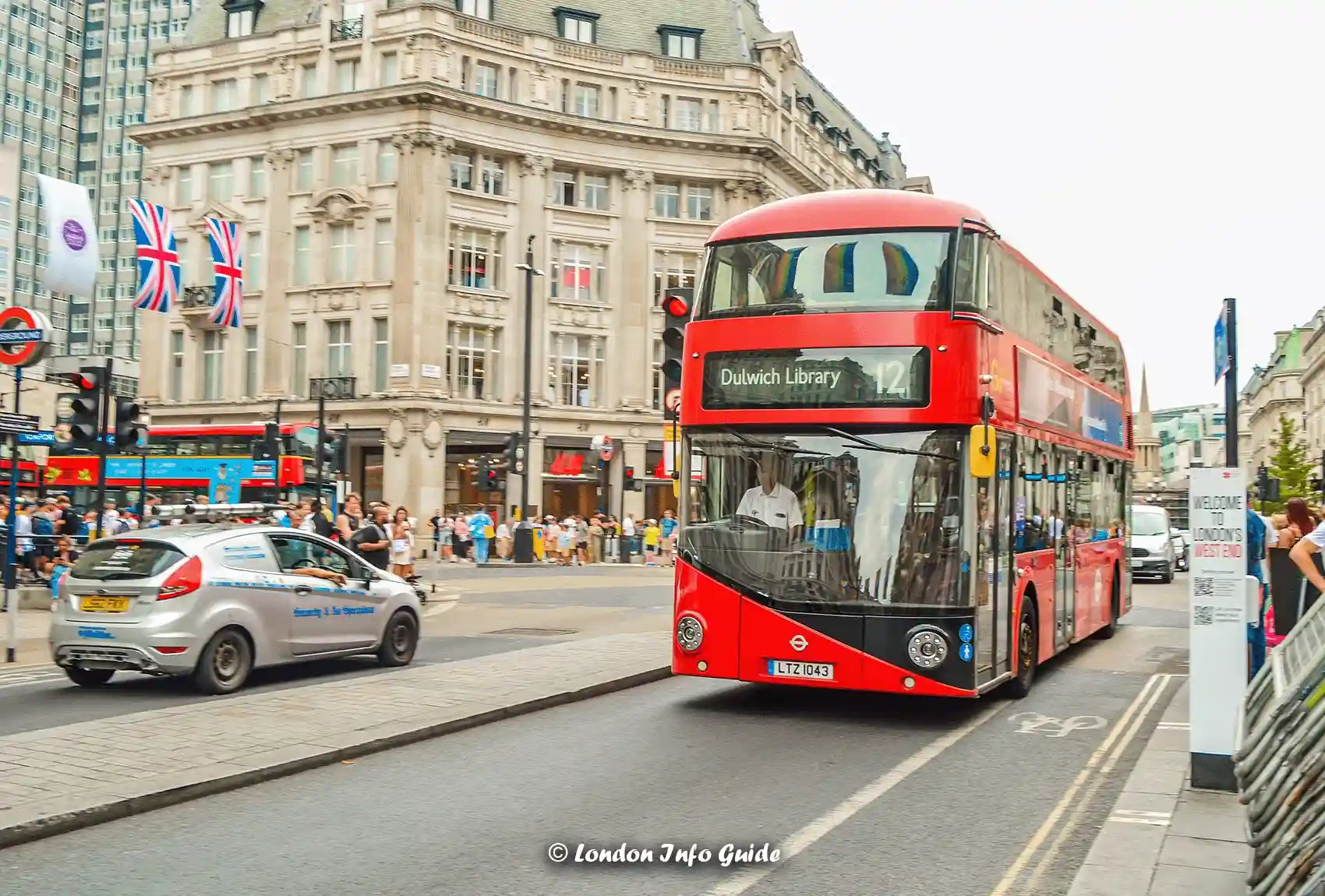 How To Get Around London | The Iconic Red Double Decker
How To Get Around London | The Iconic Red Double DeckerThe famous red double-decker buses of London are an important mode of transportation throughout the city. The buses cover all locations, offer regular service, and accept Oyster cards and contactless payments, making them a convenient transportation option.
It is possible to take a bus across London, linking the city's core districts with outlying neighbourhoods and key tourist attractions. Each of the 9,300 vehicles connected to TfL's 675 routes is identified by a unique number, and they are all wheelchair accessible.
Cashless payments are accepted with Oyster cards and contactless cards. Most routes run from 5:00 a.m. to midnight, with some 24-hour and night buses available. Buses run every 5-10 minutes during peak hours, offering regular service.
To make the most of your bus ride, utilise apps to follow timetables and always double-check the number and route before boarding. Buses are well-connected to the London Underground, Overground and rail services, making them an attractive and cost-effective mode of transportation.
The Docklands Light Railway (DLR)
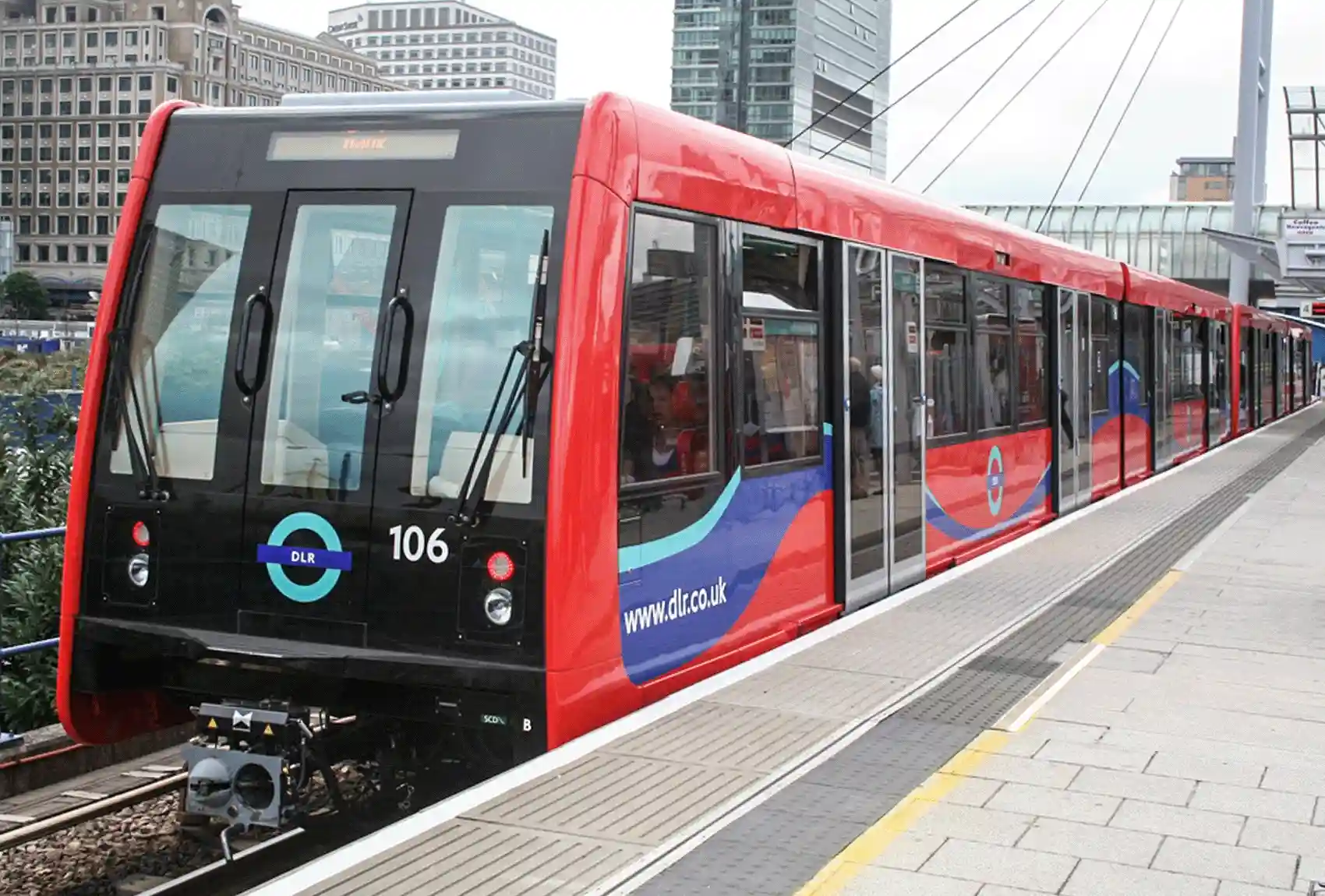 The Docklands Light Railway (DLR)
The Docklands Light Railway (DLR)The Docklands Light Railway (DLR) is an automated light rail system that serves East and South East London, primarily the Docklands district. It offers efficient, autonomous travel to critical destinations like Canary Wharf, Greenwich and Stratford, with frequent and dependable service. The DLR has six lines, including routes from Bank to Lewisham and Stratford International to Woolwich Arsenal, and provides broad coverage across the Docklands region.
Trains come every 4–10 minutes, depending on the line and time of day. Service hours are curtailed on holidays, with no service on Christmas Day and varying timetables for New Year's. Terminal stations identify lines, which are colour-coded on maps for ease of navigation. As a completely automated system, guests may enjoy a panoramic view from the front seat.
- Docklands Light railway prices: Fares vary by zones crossed; Oyster cards are accepted for seamless travel.
- Operating Hours: Operates 5:30 AM to midnight (weekdays/Saturdays), and 7:00 AM to midnight (Sundays).
- Airport Connection: Directly connects to London City Airport for convenient air travel.
- Integration with Other Transport: Connects with Underground, buses, and other rail services for comprehensive city coverage.
- Check out the Docklands Light Railway DLR map
Navigating London: Essential Tips For First-Time Visitors
London's transport network, operated by Transport for London (TfL), is highly integrated, ensuring smooth travel for both residents and visitors. This guide contains essential suggestions for utilising the system, ranging from accessibility to safety precautions, to help you travel the city with ease.
London's integrated transit system assures uniform payment methods, operation hours, and accessibility across all stations and modes. However, some variations might require attention. This page explains the system's basic features and guides you through a flawless travel experience.
- Your Accommodation: For the best convenience, choose a hotel near underground stations or other modes of transportation.
- Essential Apps: Use TfL Go and Citymapper for real-time updates, route planning, and service notifications.
- Safety: Follow safety guidelines, use CCTV-equipped services, and seek help from TfL officials if necessary.
- Plan Your Journey: The TfL Journey Planner tool provides real-time information and the best route alternatives.
- Check Service Status: Before you go, check the TfL website or app for any interruptions or scheduled engineering work.
- Travel Off-Peak: Avoid peak hours (7:30-9:30 AM and 4:30-7:00 PM) for a more comfortable and less congested trip.
- New Year's Eve Peak: Be careful of station closures and bus route changes due to New Year's Eve celebrations.
- Mind The Gap: Be aware of the space between the train and the platform when boarding and alighting; listen for safety announcements.
- Stay Safe: All trains and stations are equipped with CCTV. Look for TfL workers if you want assistance.
- Mobility Services: Accessible transportation alternatives include step-free access, priority seating, and Dial-a-Ride services.
- Running Hours: Most transit services have overlapping hours; however, check specific timetables, particularly during holidays such as Christmas and New Year's, for any changes.
- Integration with Other Transit: London's public transit network provides for seamless transfers between buses, trains, and the Underground, assuring complete city coverage.
trams in london
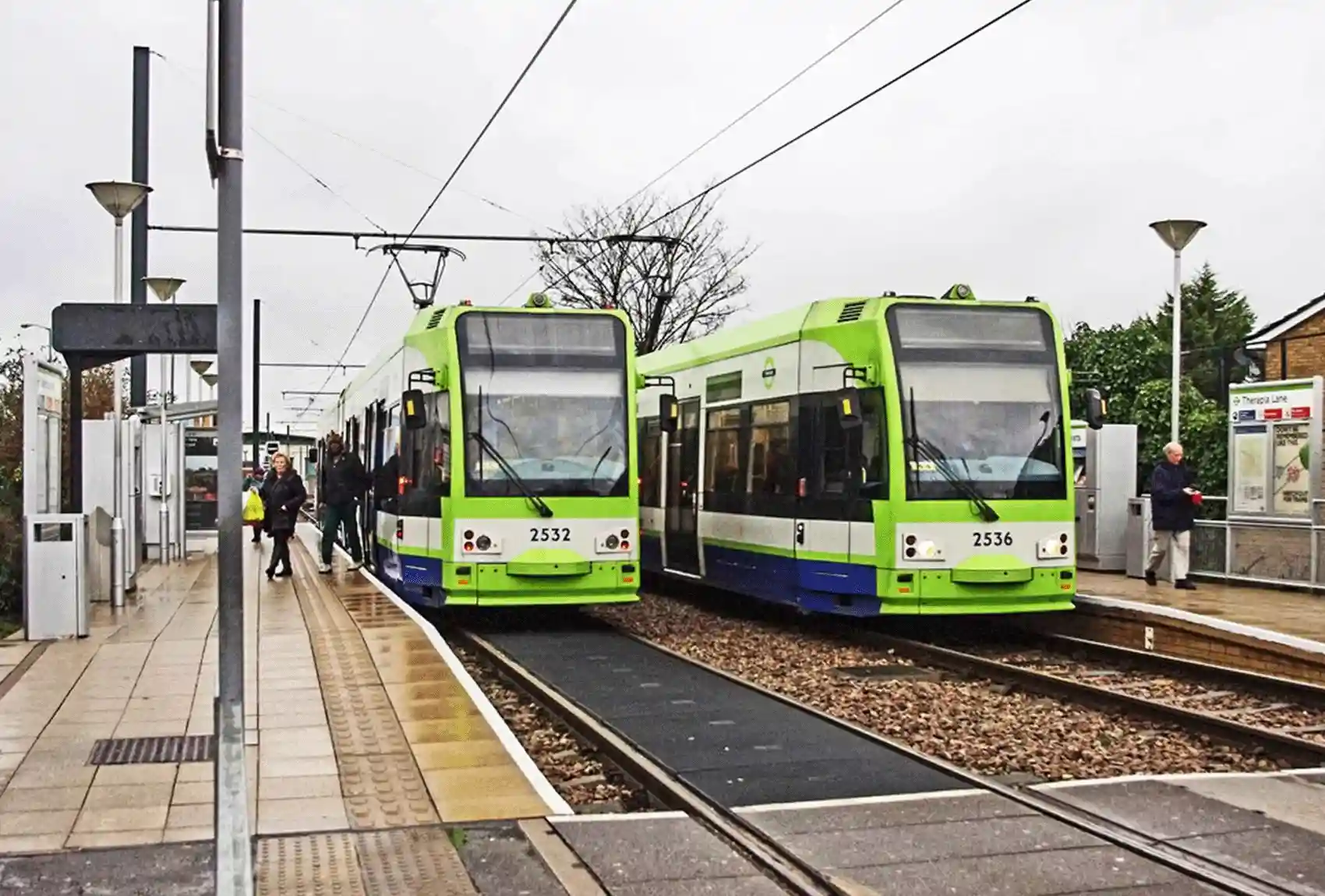 Trams In London | Tramlink in South London, are primarily green and white.
Trams In London | Tramlink in South London, are primarily green and white.The London Tram link, commonly known as the London Tram, is a modern, efficient tram system serving South London since 2000. It connects key areas such as Croydon, Wimbledon, Beckenham, and New Addington, offering a reliable mode of transport with over 39 stops across four main routes. Integrated with London's public transport network, Tram Link allows seamless transfers with trams, buses, and trains, accepting Oyster cards and contactless payments for hassle-free travel.
Operating from early morning until midnight, with trams arriving every 7-10 minutes during peak times, it ensures frequent service. All trams and stops are fully accessible, featuring step-free access for passengers with mobility issues. Although it doesn't directly connect to airports, it links to major hubs for airport services.
- Cost: Tram fares match bus fares; payments via Oyster cards, contactless payments, and Travelcards are accepted.
- Frequency: Trams run every 7-10 minutes during peak hours, with slightly less frequent off-peak service.
- Operating Hours: Trams operate from 5:00 AM to midnight, offering frequent service for commuters and tourists.
- Connections with Other Transport: Tram link connects with Underground, Overground, National Rail, and buses at major interchanges like Wimbledon.
- Check out the Trams in London map.
London river Bus
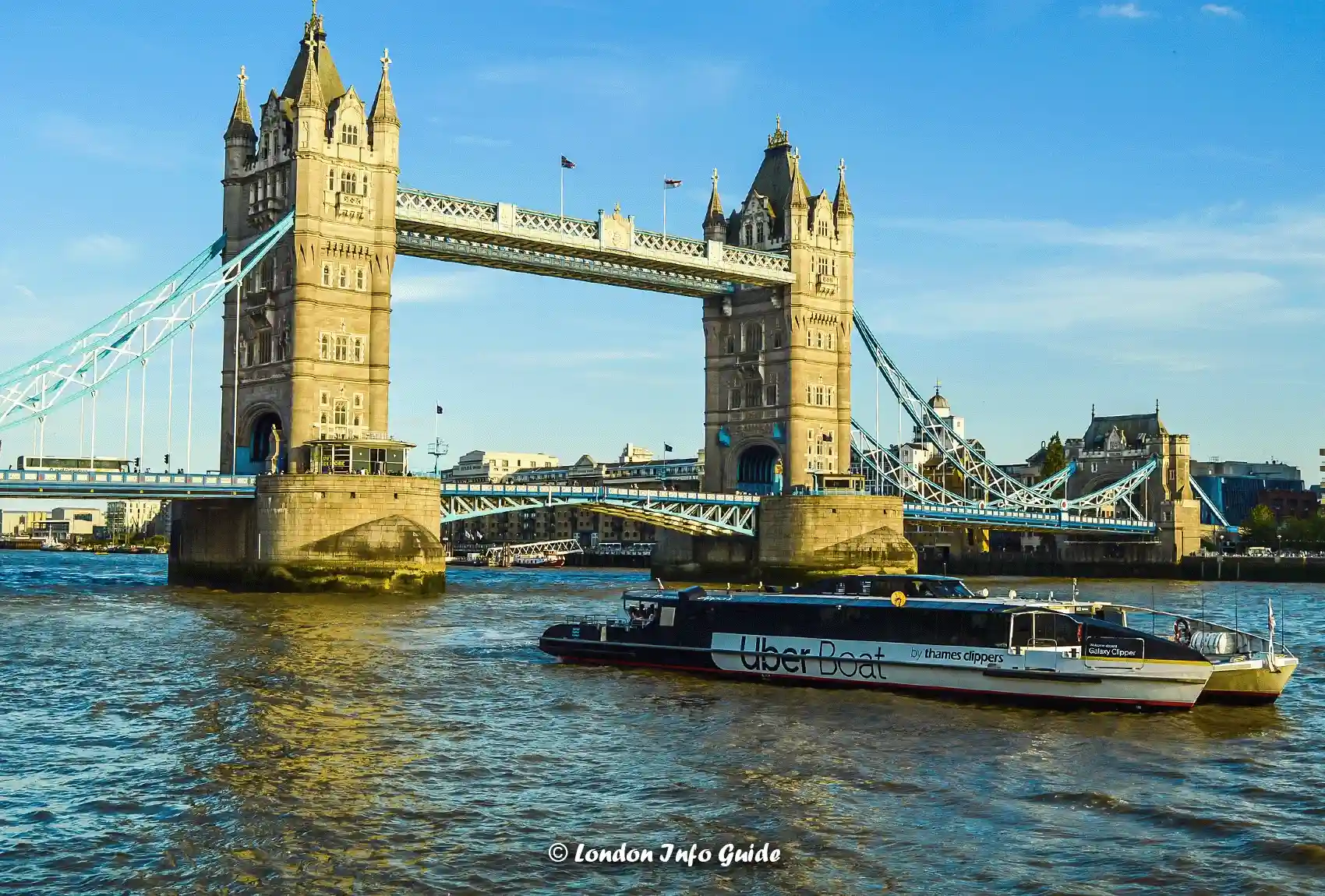 Explore London from the water with Uber's taxi boat service.
Explore London from the water with Uber's taxi boat service.With London River Transport, you can enjoy the charm and convenience of the city's distinctive canals while taking in breathtaking views of its historic sites. Thames River services provide both peaceful and picturesque alternatives to standard public transportation along London's lifeblood, the River Thames. With twelve lines, 25 stops, and six boats, London's river buses connect prominent locations such as Greenwich, Canary Wharf, and Westminster. Visitors and locals alike gain access to an efficient form of transportation through this method.
- Cost: Passengers can use Oyster cards and contactless payments for easy fare payment.
- Operating Hours: It operates from 6:00 am to 01:00 am every day.
- Check out the River Taxi London services map
Taxis and Ride-Sharing
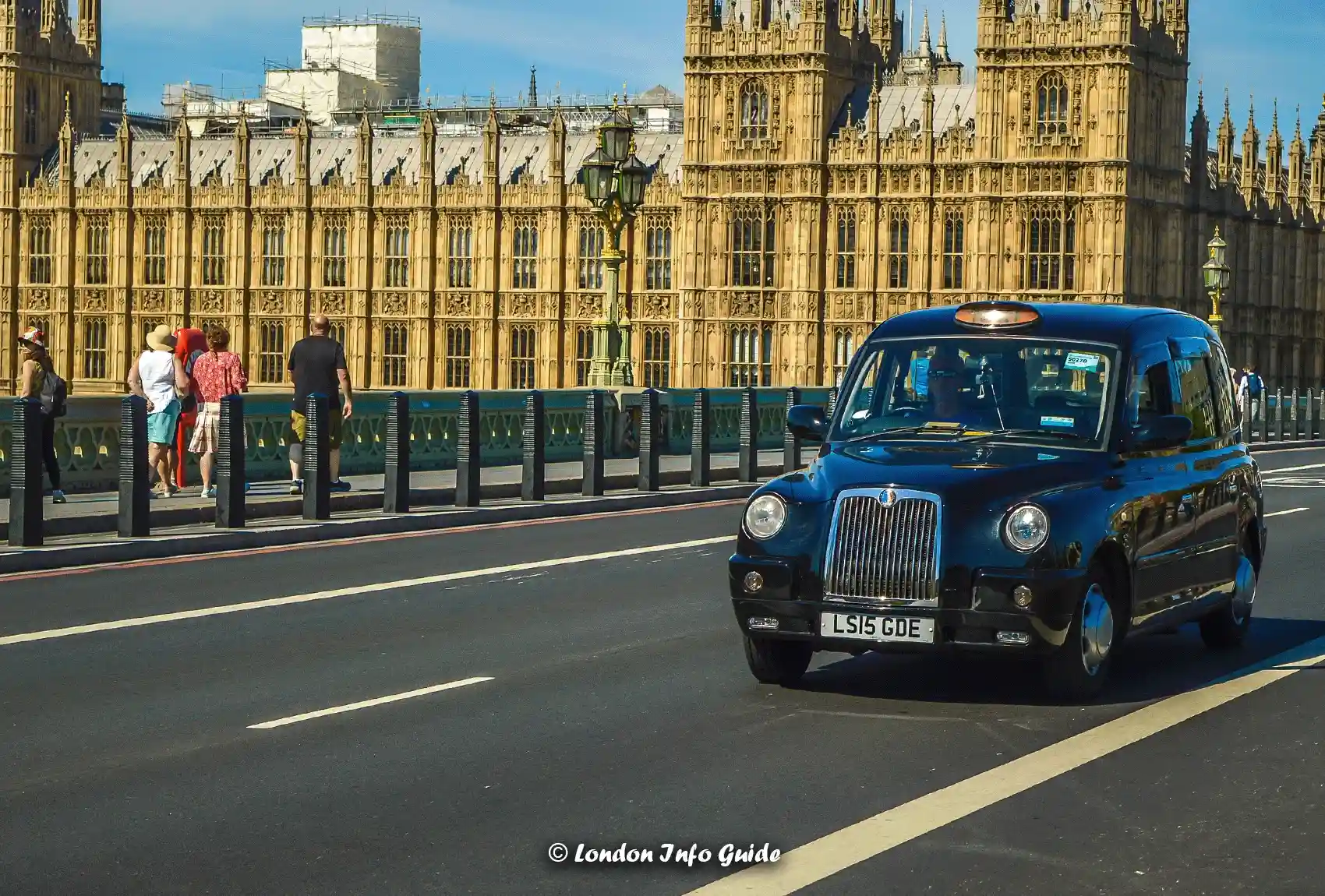 London's Iconic Black Cab, a symbol of the city’s history and cultural
London's Iconic Black Cab, a symbol of the city’s history and culturalTaxis and ride-sharing services are available in London for flexible and convenient travel. There are iconic Black Cabs, minicabs, and ride-hailing services such as Uber and Bolt running around the clock. Both residents and visitors can take advantage of these services, as they integrate smoothly with public transit.
Taxis and ride-sharing services provide convenient transportation in London. In one of the world's most lively cities, understanding the expenses, booking process, and safety precautions can ensure a smooth and comfortable journey.
walking + cycling your way through london
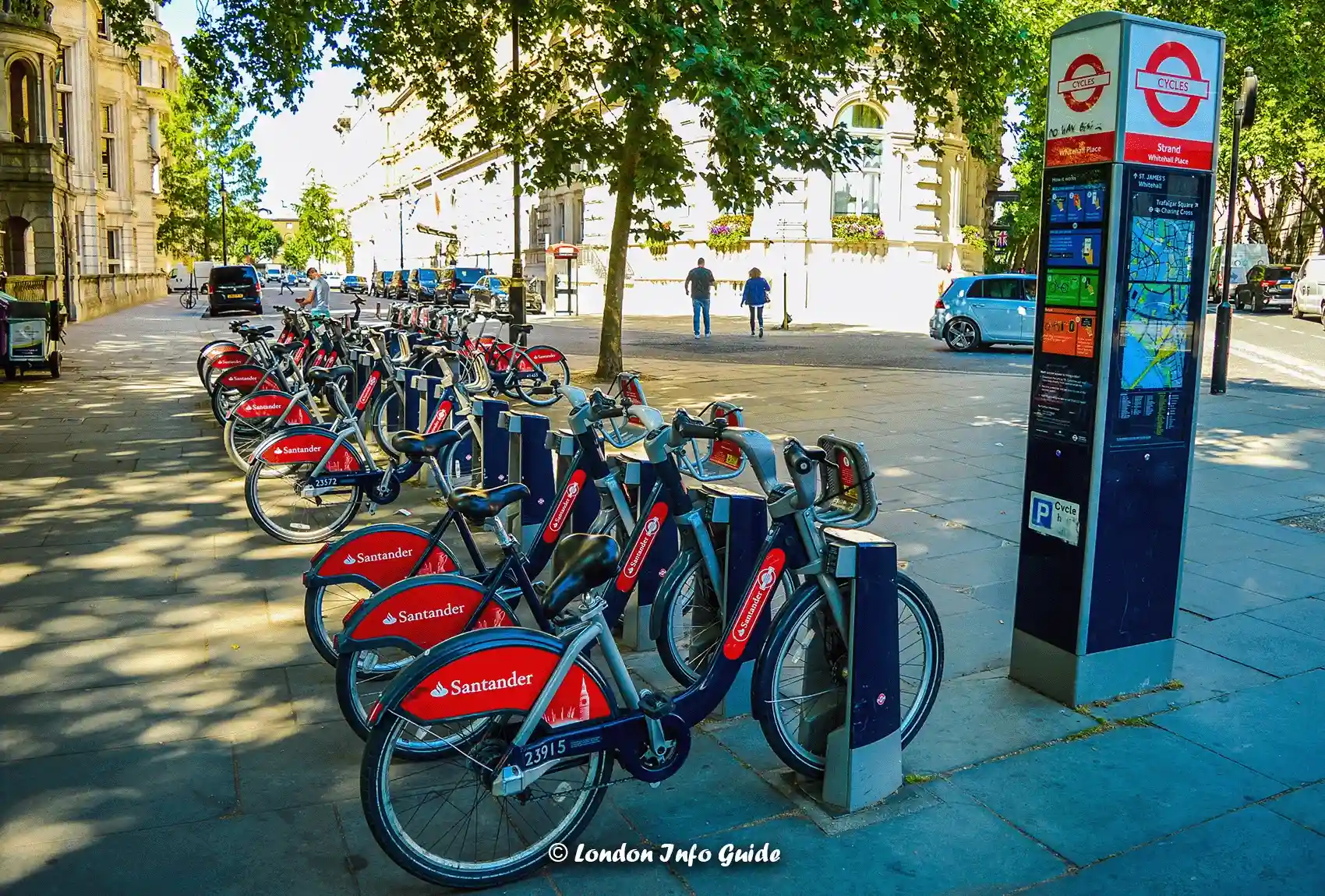 Cycling In London | Parking bays for bicycles are conveniently located on pavements
Cycling In London | Parking bays for bicycles are conveniently located on pavementsWalking and cycling are excellent ways to visit London since they provide picturesque routes, ease and a healthy, environmentally friendly means of transportation. Both means of transport are highly supported, with wide bike lanes, dedicated routes, and low-cost rental choices.
Following traffic regulations and safety recommendations lead to a pleasurable experience. The Thames Path and the Royal Parks are popular walking paths, as do the Cycleways connect neighbourhoods, businesses, and attractions. All riders can feel comfortable and confident using them since they are easy to operate.
Check out more cycling information by the Transport for London.
Further reading: Top Free Walking Tours Around London
IFS Cloud cable car
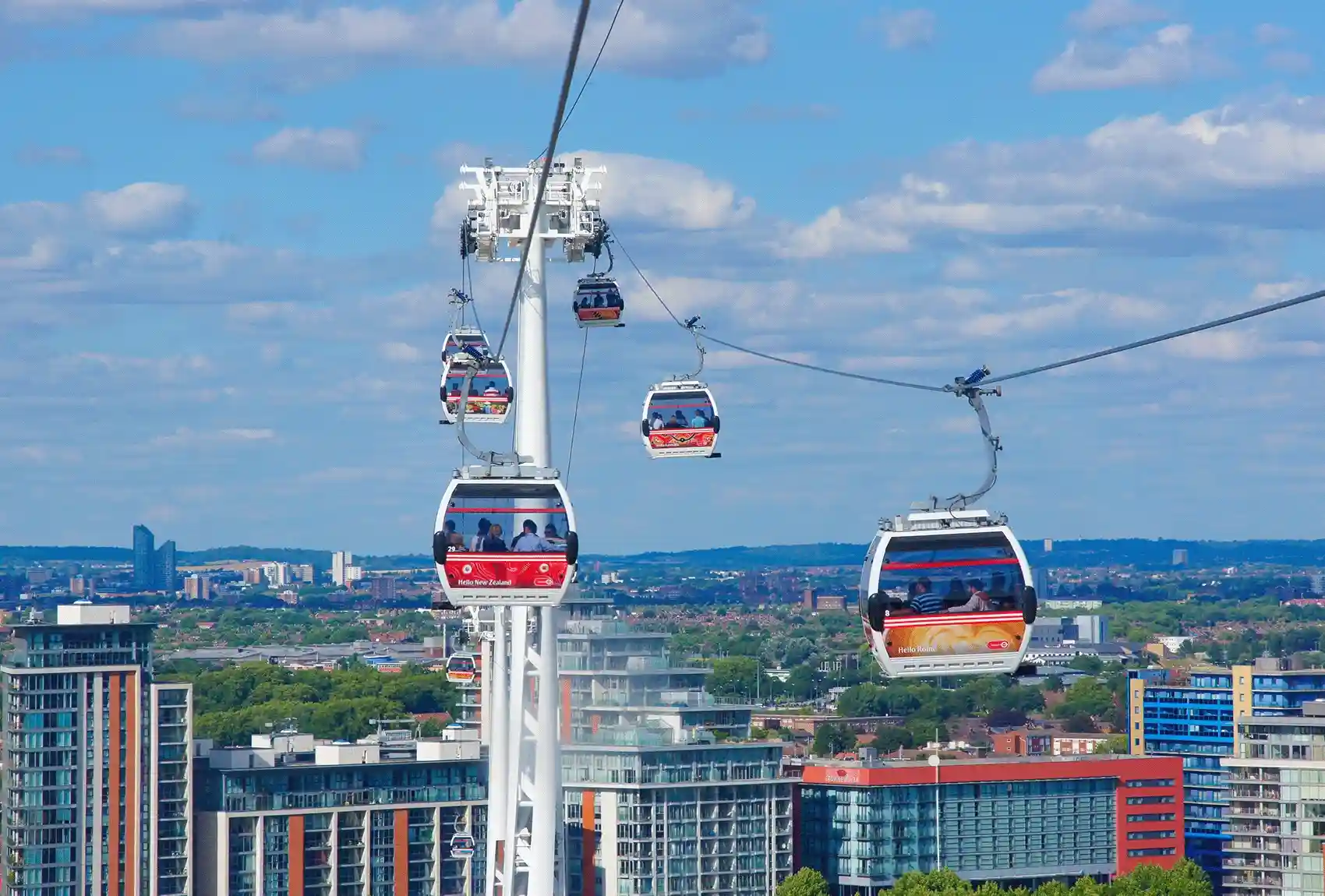 Getting Around In London | Emirates Airline IFS Cloud Cable Car
Getting Around In London | Emirates Airline IFS Cloud Cable CarThe London Cable Car, commonly known as the Emirates Air Line, provides breathtaking aerial vistas as it crosses the River Thames. It offers a one-of-a-kind travel experience by connecting the Greenwich Peninsula and the Royal Docks. Clear weather is ideal for riding since it provides unimpeded views of the city. Combine the journey with stops at neighbouring sights such as The O2 and ExCeL London. It is completely accessible, accepting Oyster cards and linking to other modes of public transport. The cable car operates every day with altered holiday hours and is a practical and picturesque mode of transportation.
- Operating Hours: Monday to Friday 7:00 AM to 10:00 PM, Saturdays: 8:00 AM to 10:00 PM, Sundays and Bank Holidays: 9:00 AM to 10:00 PM.
- Frequency: Arrives every 30 seconds during peak times.
- Integration with Other Transport: Connects North Greenwich to the Jubilee Line and Royal Victoria to the Docklands Light Railway.
transport of getting to london and beyond
Have a look at the different ways of getting to and from London and beyond by using the different transportation options: The National Rail Network, Eurostar, and Coaches.
Airports and transfers
Plan your route to London via plane or train. The city's multiple airports and rail facilities provide handy connections to locations throughout the UK and overseas.
The National Rail Network
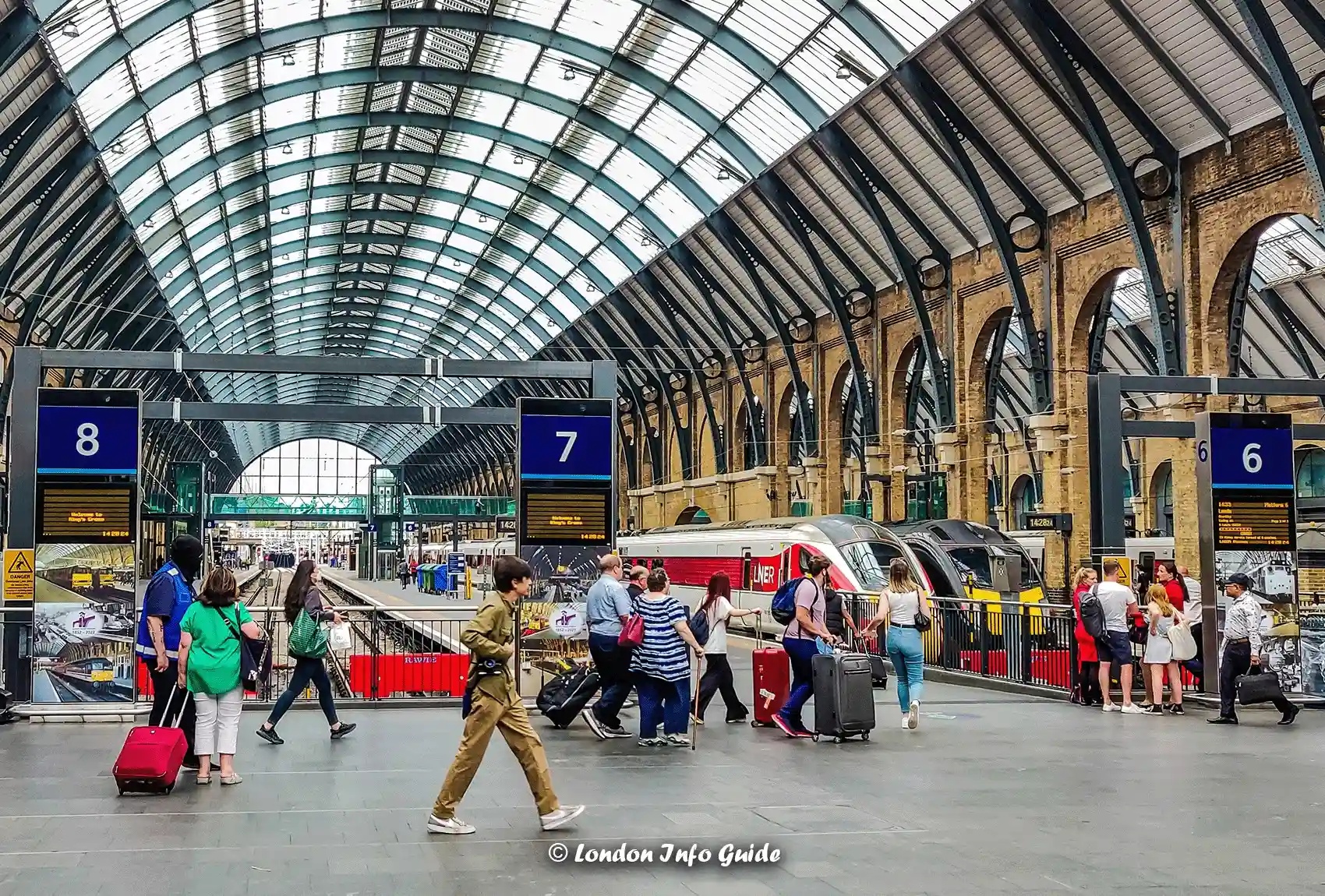 London Public Transport | King's Cross Station London, UK
London Public Transport | King's Cross Station London, UKThe National Rail system connects London with important UK cities like Birmingham, Manchester, and Edinburgh, as well as the main London terminals of Paddington, King's Cross, and Waterloo. The service is regular, provides wide coverage, and connects quickly to airports, but is restricted during the holidays. To avoid discomfort, it is recommended that you check the timetable on the National Rail website, and try to avoid busy hours of the day.
Check out the National Rail Map London.
Eurostar - Trains from london to paris And Europe
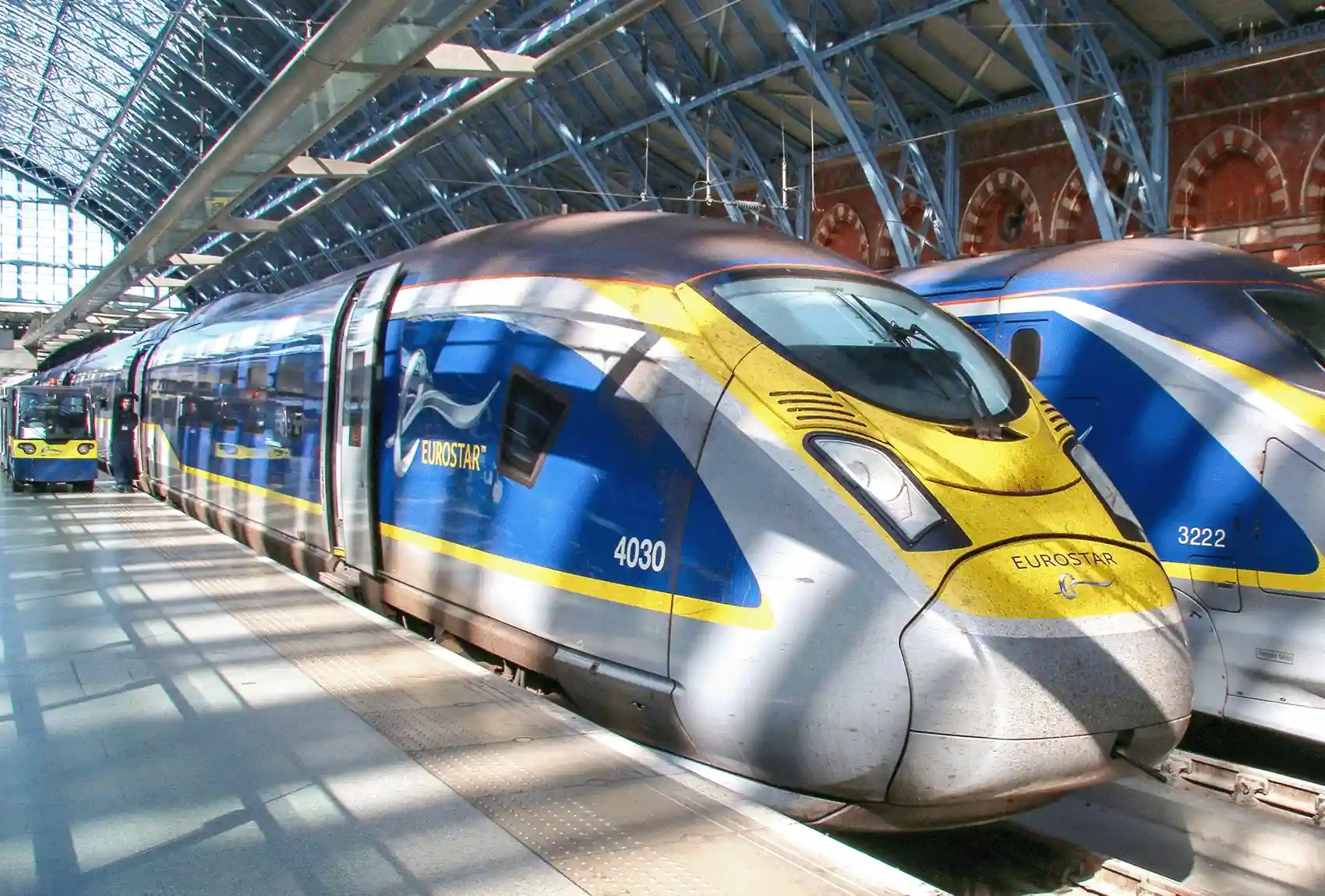 Station for Eurostar in London
Station for Eurostar in LondonEurostar is the primary high-speed rail service that connects London to important locations in France and Europe, providing a quick, pleasant, and environmentally responsible travel choice. Eurostar trains depart from London's St Pancras International and proceed to Paris, Brussels, Amsterdam, and other essential cities, taking much less time than flying. With speeds of up to 186 mph (300 km/h), Eurostar offers a smooth ride through the Channel Tunnel, making it a popular choice for both business and pleasure travellers.
Whether you're planning a day trip to Paris or a business trip to Brussels, Eurostar provides an efficient and fun method to travel between London and Europe.
Coaches and Connections: london Victoria Station
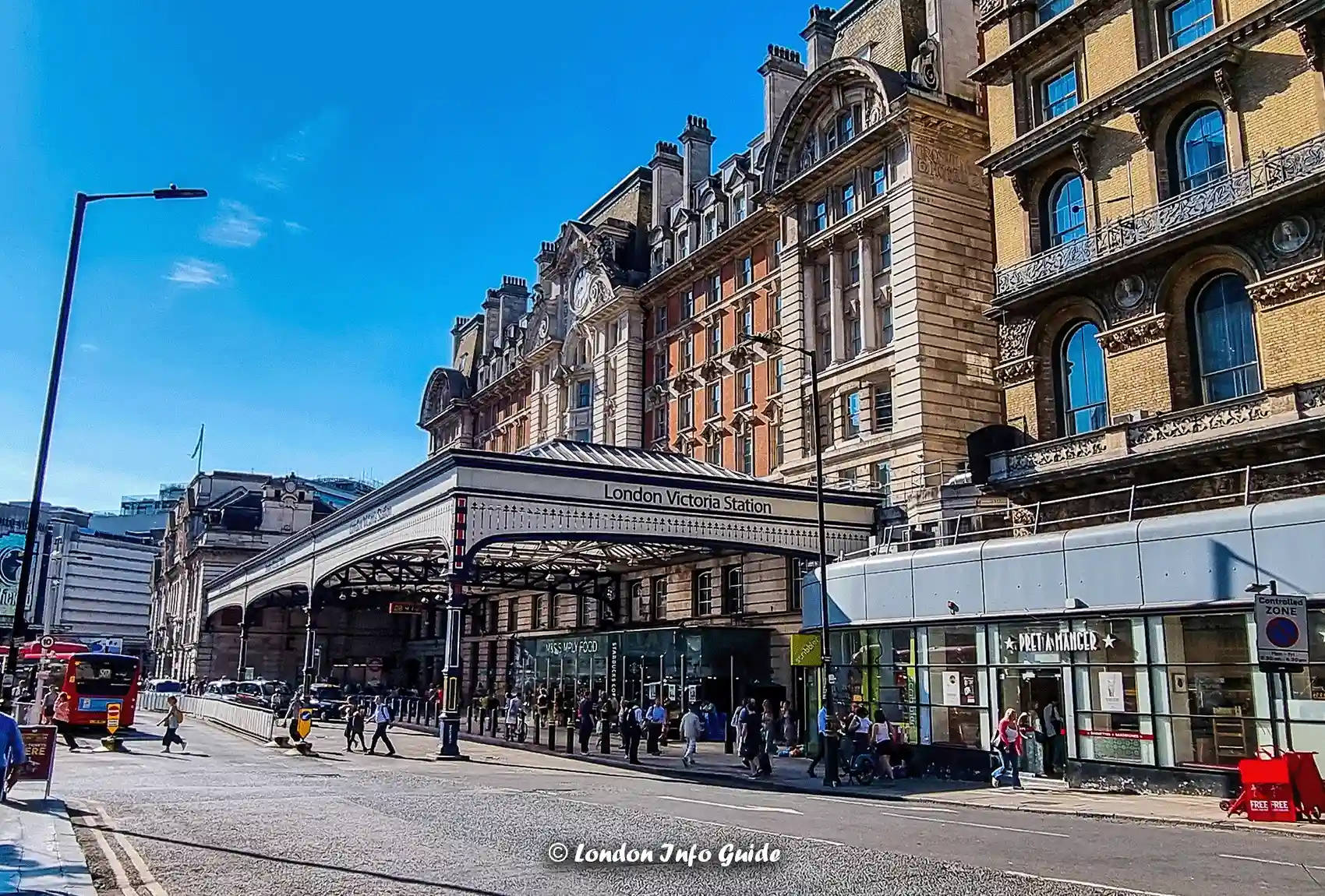 How to Get Around London | Victoria Bus Station, London, England
How to Get Around London | Victoria Bus Station, London, EnglandThe station is conveniently located near Victoria Railway Station and the underground, providing a cost-effective and pleasant travel experience throughout the UK and Europe. In addition to waiting lounges and cafés, the station has shops, step-free access, and accessible bathrooms. The service runs 24 hours a day, 7 days a week, and it accepts early and late arrivals, making it an ideal alternative to trains and planes. Its ease and dependability make it a popular choice among many travellers.
Frequently asked questions - The London Transport system
What is the difference between the London Underground and the London Overground?
What is the difference between the London Underground and the London Overground?
The London Overground is a suburban rail network that serves the wider London region, linking places beyond the central zones that are often visited by the Underground. It is primarily above ground.
What are the primary modes of transport in London?
What are the primary modes of transport in London?
The Underground, buses, Overground, DLR, trams, and National Rail provide extensive connectivity across London.
How do I use the London Underground?
How do I use the London Underground?
Use an Oyster card or contactless payment, read signage, and consult maps for routes.
How much does it cost to use the Tube?
How much does it cost to use the Tube?
Costs vary depending on transit zone, peak/off-peak periods, and payment mode (Oyster, contactless, Travelcards).
How do I pay for public transportation in London?
How do I pay for public transportation in London?
Use Oyster cards, contactless payments, Travelcards, or smartphone applications for quick fare payment.
What is an Oyster card and where can I buy one?
What is an Oyster card and where can I buy one?
A prepaid travel card is accessible at stations, online, or at Visitor Centres.
How does contactless payment work on public transport?
How does contactless payment work on public transport?
Simply tap your contactless card or device on the reader at the entrance and exit points.
What are the peak and off-peak travel periods?
What are the peak and off-peak travel periods?
Peak hours are 6:30-9:30 AM and 4:00-7:00 PM on weekdays, while off-peak hours are all other times.
How to use London's bus system?
How to use London's bus system?
Use maps, TfL apps, or stop signs to find routes and timetables.
Are there applications that can assist me plan my trip routes?
Are there applications that can assist me plan my trip routes?
Apps such as TfL Go, Citymapper, and Google Maps offer route planning and updates.
How do I use the London Overground and DLR?
How do I use the London Overground and DLR?
Similar to the Tube, use Oyster, contactless, or Travelcards and refer to maps for itineraries.
Where can I obtain information about rail services to other UK cities?
Where can I obtain information about rail services to other UK cities?
The National Rail website and app offer timetables, tickets, and booking choices.
How can I travel to and from London's airports?
How can I travel to and from London's airports?
Take the Tube, rail, bus, or airport-specific services like Heathrow Express.
What are the distinctions between black cabs, minicabs, and ride-sharing services?
What are the distinctions between black cabs, minicabs, and ride-sharing services?
Black taxis may be hailed, while minicabs must be pre-booked. Ride-sharing services, such as Uber and Bolt, are available through apps.
Are there passes or tickets for tourists?
Are there passes or tickets for tourists?
The Visitor Oyster Card and London Travel Card provide handy transport alternatives.
Is public transport accessible to individuals with disabilities?
Is public transport accessible to individuals with disabilities?
Most routes include step-free access, preferential seating, and assistance to handicapped customers.
How safe is public transit in London?
How safe is public transit in London?
Overall safe, with significant CCTV, personnel presence, and frequent security measures.
Which is the best method to travel at night?
Which is the best method to travel at night?
Take the Night Tube, night buses, licenced taxis, or ride-sharing services.
Find The Best Places To Stay Nearby
This fantastic interactive map below helps you discover the best accommodation across London from a variety of trusted platforms. Explore different neighbourhoods, compare prices, and book directly all under one platform.
Want To Share This Page On Pinterest? Pin It Here!
Photo sources - how to get around London
- TfL London Overground - Kevin.B, CC BY-SA 3.0 , via Wikimedia Commons
- Docklands Light Railway DLR London - Hippoattack at English Wikipedia, Public domain, via Wikimedia Commons
- Emirates Airline London Cable Car - Chris Sampson, CC BY 2.0 , via Wikimedia Commons
- London to Paris Eurostar - kitmasterbloke, CC BY 2.0 , via Wikimedia Commons
- Trams in London - P L Chadwick / London Tramlink Bombardier trams nos. 2532 & 2536 at Therapia Lane tram stop, Croydon
